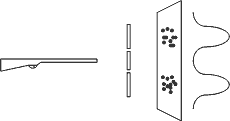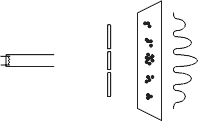 The problem of quantum mechanics and proposed solutions can be explained through an imaginary meeting between Physicists. We start with the Classical Physicist, who sets up an assembly including a gun, a piece of armor plate with two holes in it, and a screen behind it that can capture a bullet. When he randomly fires his gun at the armor plate, most of his bullets will be stopped; some, however, will go through one or the other hole and hit the screen behind. Most of the bullets that go through will fly along a straight path, but some will be slightly deflected as they hit the side of the hole; the pattern on the screen will be two spots of impacts, with the heaviest concentration of impacts near the center.
The problem of quantum mechanics and proposed solutions can be explained through an imaginary meeting between Physicists. We start with the Classical Physicist, who sets up an assembly including a gun, a piece of armor plate with two holes in it, and a screen behind it that can capture a bullet. When he randomly fires his gun at the armor plate, most of his bullets will be stopped; some, however, will go through one or the other hole and hit the screen behind. Most of the bullets that go through will fly along a straight path, but some will be slightly deflected as they hit the side of the hole; the pattern on the screen will be two spots of impacts, with the heaviest concentration of impacts near the center.
When next the Classical Physicist replaces his gun firing lead bullets with an electron gun that fires single electrons, he rightfully expects the same pattern to develop; much to his surprise, that's not what happens, but instead, the impact spots on the screen will develop into an interference pattern. The Classical Physicist is bewildered: while he clearly sees individual electrons being fired by his gun and individual impacts being registered on the screen, overall the pattern is more akin to the pattern a wave would make. The Classical Physicist gives up and retires, passing on his job to the next generation of Quantum Physicists.
 The Quantum Physicists all agree on one thing: that whereas the motion of what we believe to be the electron is governed by a wave equation, when the electron interacts with a screen, the interaction involves discrete units of energy and momentum, giving the appearance that a specific particle has arrived. But this is where their agreement ends.
The Quantum Physicists all agree on one thing: that whereas the motion of what we believe to be the electron is governed by a wave equation, when the electron interacts with a screen, the interaction involves discrete units of energy and momentum, giving the appearance that a specific particle has arrived. But this is where their agreement ends.
The Physicist from Copenhagen1 proposes an explanation: reality consists not of particles but of states. Most of the time, reality is a "superposition" of many possible states, but when a measurement is made, a "collapse" occurs and a single "eigenstate" is picked out of the collection of states. He looks around smugly, until another Physicist, carrying Erwin2 the cat on his lap, raises an objection: "What, pray tell, is a 'measurement'?"
The Physicist with the Cat explains: "Suppose we put a sensor on your screen here," he points. "This sensor will be triggered fifty percent of the time. We then use this sensor's signal to operate a hammer here, cracking open a vial of poison gas. Next to the vial we place the cat. We seal this whole assembly in a closed box and fire off a single electron. At what point will you consider that a 'measurement' has been made? When the hammer hits? When the cat dies? Or will the cat be in a superposition of 'dead' and 'alive' eigenstates until a Physicist opens the enclosure and peers inside the box, 'measuring' the state the cat is in?"

The Physicist from Copenhagen falls silent for a moment, but then regains his composure. "It doesn't matter," he says. "What matters is that our calculations accurately describe nature. We don't really have to actually understand what we are doing. In any case," he adds, "in all practical situations we can easily tell what constitutes a measurement and what doesn't, so your gedankenexperiment is an exercise in futility." He then stomps out of the room, leaving the other Physicists behind.
"Hey, I have a solution," says a Physicist from the small town of Everett3, Michigan. "I don't think the wave function ever collapses," he says, looking around seeking signs of support and approval among his peers. "What I believe happens is that all possible states continue to exist simultaneously; our existence simply marks a particular path among these parallel worlds, while an infinitude of our alter egos trace out alternate paths." He sits down when he realizes that no one came forth to offer support for his idea, that there were no nods of approval among his audience.
Up jumps a Physicist who, by his appearance, could be mistaken for a telephone company employee: he is wearing a jacket with the symbol of a bell4 emblazoned on the front. "I think it is time to take a closer look at what the electron 'knows', indeed what the electron can 'know' about its surroundings. Could it be that all the information about its future impact location is encoded within the electron at the time it is fired, perhaps hidden from us but guiding the electron nevertheless?" He goes to a blackboard on which he scribbles some equations about probability and pairs of socks5. He then pronounces his conclusion: no, the electron could not have known in advance where it was going to hit the screen. "But," he raises his hand to quiet down his excited audience, "this information could have been there, encoded in the totality of spacetime, not localized to any particular time and position."
"But this is exactly what we've been proposing all along," shouts a person, perhaps a car mechanic by appearance, as the oily jacket he wears bears the words, "Bohmian Mechanic"6 on its back. "The information about where the electron can travel is encoded non-locally in the wave function, which really serves as a 'pilot wave'. Where the electron ends up is fully determined by this pilot wave, but the pilot wave's shape is defined not only by the initial conditions but also by the experiment's outcome, as the pilot wave is fundamentally non-local both spatially and temporally."
Hmmm, maybe he isn't just a car mechanic after all. Never mind, he is shouted down anyway: "Nonsense!" cries loudly an individual who, if you didn't know any better, you'd assume to be a bank teller, he's so enamored with Transactions7. "You cannot have such transluminal garbage and call it a physical theory! What you need is some decent, Lorentz-invariant explanation of the physics that's going on. And that is precisely what we propose: for every particle moving forward in time, we believe that there is a shadow particle moving backward in time carrying the necessary information to complete a transaction. Not all forward-moving and backward moving particles meet, and those that don't never acquire a real, physical existence. But when a meeting occurs, a Transaction takes place and you see a quantum event. Everything is nice and deterministic, and you can compute the exact outcome of a quantum experiment; of course for this you require information from the future in order to compute the properties of the Advance Wave."
The crowd erupts with shouts like, "Preposterous!" And, "Telegrams from the future, indeed!" Many others, however, consider the idea seriously, including a young Experimental Physicist with a German accent8. "But," he interjects, "I vas alvays taught dat Quantenmechanik to time reversal insensitive ist. Your Advance Vave und Retarded Vave differently behave. How can you dat explain?"
There is no reply from the Transactional Physicist, and the meeting breaks up. Unconvinced by others, but unsure of their own views, the Physicists leave, disappointed. Fresh ideas are needed, but they know not where to find them. Yet.
1This "traditional" interpretation of Quantum Mechanics is called the Copenhagen interpretation, named after the city of residence of Niels Bohr, whose institute served as a meeting place for the world's leading quantum physicists in the 1920s.
2Named after Erwin Schrödinger, who supposedly first proposed this thought experiment involving a cat.
3This imaginary town (as far as I know, there's no town named Everett in Michigan) is named after Hugh Everett III, an American quantum physicist who gave birth to the many-world interpretation.
4John Bell is most famous for his inequality that demonstrates a fundamental difference between classical and quantum behavior.
5In one of his many articles, John Bell attempted to explain quantum reality using an example involving a pair of socks.
6The interpretation commonly called Bohmian mechanics is named after its inventor, David Bohm.
7An allusion to the so-called transactional interpretation proposed by John Cramer and others.
8I recently corresponded with a young German physicist, an exchange that gave me the inspiration to write this article. The accent and the faux German grammar are of my own invention.


